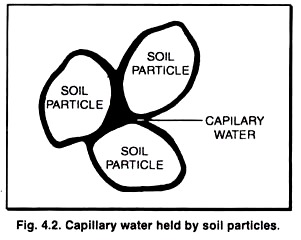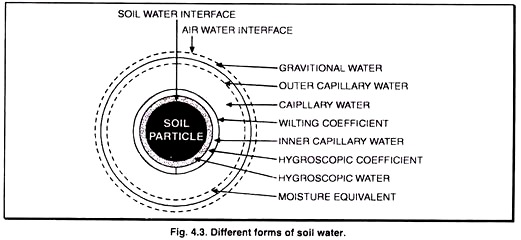ADVERTISEMENTS:
After reading this article you will learn about the physical and biological classification of soil water.
Physical Classification of Soil Water:
From a physical point of view the terms gravitational, capillary and hygroscopic waters are identified.
The forms of soil moisture are:
ADVERTISEMENTS:
1. Gravitational Water:
Gravitational water occupies the larger soil pores (macro pores) and moves down readily under the force of gravity. Water in excess of the field capacity is termed gravitational water. Gravitational water is of no use to plants because it occupies the larger pores. It reduces aeration in the soil. Thus, its removal from soil is a requisite for optimum plant growth.
2. Capillary Water:
Capillary water is held in the capillary pores (micro-pores). Capillary water is retained on the soil particles by surface forces (Fig. 4.2). It is held so strongly that gravity cannot separate it from the soil particles. The molecules of capillary water are free and mobile and are present in a liquid state. Due to this reason it evaporates easily at ordinary temperature. Though, it is held firmly by the soil particle, plant roots are able to absorb it. Capillary water is, therefore, known as available water.
3. Hygroscopic Water:
The water held tightly on the surface of soil colloidal particles is known as hygroscopic water. It is essentially non-liquid and moves primarily in the vapour form. Hygroscopic water held so tenaciously by soil particles that plants cannot absorb it. Some microorganism may utilise hygroscopic water. As hygroscopic water is held tenaciously by soil particles that plants cannot absorb it.
Some microorganism may utilise hygroscopic water. As hygroscopic water is held tenaciously by surface forces its removal from the soil requires a certain amount of energy. Unlike capillary water which evaporates easily at atmospheric temperature (it requires very little energy for its removal), hygroscopic water cannot by separated from the soil unless it is heated (Fig. 4.3).
Factors Affecting Gravitational Water:
ADVERTISEMENTS:
1. Texture plays a great part in controlling the rate of movement of gravitational water. The flow of water is proportional to the size of particles. The bigger the particle, the more rapid is the flow or movement. Because of the larger size of pore (tube), water percolates more easily and rapidly in sandy soils than in clayey soils.
2. Structure also affects gravitational water. In platy structure movement of gravitational water is slow and water stagnates in the soil. Granular and crumby structure help to improve gravitational water movement. In clayey soils having single-grain structure, the gravitational water percolates more slowly. If clay soils form aggregates (granular structure), the movement of gravitational water improves.
Factors Controlling Amount of Capillary Water:
ADVERTISEMENTS:
The amount of capillary water that a soil is able to hold varies considerably.
There are four main factors that are responsible for variation in the amount of capillary water:
(1) Surface tension of the water film,
(2) Soil texture,
ADVERTISEMENTS:
(3) Soil structure, and
(4) Organic matter.
1. Surface tension:
An increase in surface tension increases the amount of capillary water.
2. Soil texture:
The finer the texture of a soil the greater the amount of capillary water it holds. This is mainly due to the greater surface area and a greater number of micro pore spaces.
3. Soil structure:
Platy structure contains more water than granular structure.
4. Organic matter:
The presence of organic matter helps to increase the capillary capacity of a soil. Organic matter itself has a great capillary capacity. Un-decomposed organic matter is generally porous having a large surface area which helps to hold more capillary water. The humus that is formed on decomposition has a great capacity for absorbing and holding water. Hence, the presence of organic matter in soil controls the amount of capillary water.
Factor Affecting Hygroscopic Water:
Hygroscopic water is held on the surface of colloidal particles by the dipole orientation of water molecules. The amount of hygroscopic water varies inversely with the size of the soil particles. The smaller the particle the greater the amount of hygroscopic water it adsorbs. Fine texture soils like clay contain more hygroscopic water than coarse texture soils.
Not only the amount of clay but also its nature influences the amount of hygroscopic water. Clay minerals of the montmorillonite type with their large surface area adsorb more water than those of the kaolinite type, while illite minerals are intermediate.
Biological Classification of Soil Water:
There is a definite relationship between moisture retention and its utilisation by plants. This classification is based on the availability of water to the plant.
Soil moisture can be divided into three parts:
1. Available water:
The available water is that water which lies between wilting coefficient and field capacity. It is obtained by subtracting wilting coefficient from moisture equivalent (Fig. 4.5).
2. Unavailable water:
The unavailable water includes the whole of the hygroscopic water plus a part of the capillary water below the wilting point.
3. Super-available or Superfluous water:
The water beyond the field capacity stage is said to be super-available. It includes gravitational water plus a part of the capillary water removed from large interstices. This water is unavailable for the use of plants. The presence of super-available water in a soil for any extended period is harmful to plant growth because of the lack of air.
While the various terms employed to describe soil water physically and biologically are useful in a practical way, but they are semi-quantitative. For example, measurement of field capacity tends to be arbitrary. Measurement of field capacity is affected by initial soil moisture before wetting the soil, removal by plants and surface evaporation etc. These facts stress that there is no clear line of demarcation between different “forms” of soil water.


